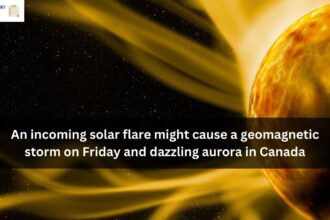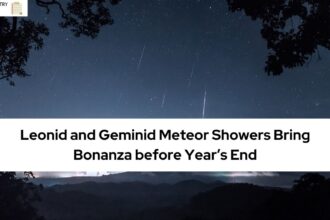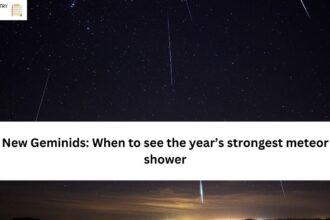Hey there, star gazers and cosmic enthusiasts! If you’ve ever found yourself staring at the night sky, wondering when the universe might put on a dazzling show, you’re in for a treat. The Leonid Meteor Shower is gearing up for its celestial performance, and you wouldn’t want to miss it. So, grab your blanket, find a cozy spot, and let’s unravel the mystery of when this cosmic spectacle will be at its most dazzling.
Setting the Stage: What is the Leonid Meteor Shower?
Before we dive into the timing, let’s get acquainted with our star of the show – the Leonid Meteor Shower. Picture this: tiny particles from the comet Tempel-Tuttle hurtling through space, entering Earth’s atmosphere, and putting on a fiery display. It’s like Mother Nature’s own fireworks show, and we get front-row seats.
Now, let’s get down to the nitty-gritty – when can you catch this celestial extravaganza at its absolute best?
1. The Nightly Prelude: Early Evening Wonders
The Leonid Meteor Shower isn’t one to keep you waiting until the wee hours of the morning. Nope, it’s considerate like that. While the shower technically peaks during the pre-dawn hours, you can catch some early evening meteors as well. Picture this: a clear, crisp night, a hot beverage in hand, and meteors streaking across the sky like shooting stars in a dream. Sounds like a pretty magical evening, doesn’t it?
2. The Pinnacle: The Wee Hours Before Dawn
Now, if you’re aiming for the grand spectacle, set your alarm clock for the wee hours before dawn. That’s when the Leonid Meteor Shower takes center stage. The peak activity usually occurs in the pre-dawn hours, providing the perfect cosmic ballet for those willing to set their alarms and venture into the night.
Imagine the world bathed in the soft glow of moonlight, a quiet stillness in the air, and meteors dancing across the sky like ethereal ballerinas. It’s a moment that makes you feel both infinitely small and wonderfully connected to the universe.
3. The Best Window: Midnight to Dawn
Okay, let’s break it down even further. The sweet spot for catching the Leonid Meteor Shower is roughly from midnight to dawn. During this magical window, the Earth is turning into the stream of comet debris, creating a cosmic symphony of shooting stars.
So, if you’re a night owl or an early bird, this is your golden opportunity. Set up your lawn chair, wrap yourself in a cozy blanket, and let the wonders of the universe unfold above you. It’s a show that doesn’t require tickets, just a willingness to embrace the beauty of the night sky.
4. Meteor Shower Etiquette: Patience is the Virtue
Now, a word of advice for fellow cosmic spectators – patience is the name of the game. Meteor showers, like any good performance, have their own rhythm. Some nights, you might witness a meteor every few minutes; other nights, it could be a meteor extravaganza with several streaking across the sky in quick succession.
So, don’t be disheartened if the first few minutes seem quiet. Nature has its own schedule, and sometimes the best things come to those who wait. Use this time to soak in the tranquility of the night, admire the constellations, and let your eyes adjust to the darkness for an optimal meteor-watching experience.
5. Ideal Conditions: Clear Skies and Away from City Lights
Now, let’s talk about the ideal setting for this cosmic spectacle. Imagine yourself away from the hustle and bustle of city lights, surrounded by the pure, velvety darkness of the countryside. That’s the dream scenario for meteor watching.
Clear skies are your best friend during a meteor shower. If clouds decide to play spoil-sport, it might hinder your view. So, scout for a location with minimal light pollution and a wide-open view of the sky. Mother Nature’s light show deserves the best seat in the house, after all.
6. Tools of the Trade: No Telescope Needed
The beauty of the Leonid Meteor Shower lies in its accessibility. Unlike some celestial events that require telescopes and intricate star maps, the Leonids are a show for the naked eye. All you need is a comfortable spot, perhaps a reclining chair, and the willingness to gaze at the starry canvas above.
Binoculars or telescopes? While they might be handy for observing other astronomical wonders, for the Leonid Meteor Shower, simplicity is key. Let your eyes be the guide, and enjoy the natural splendor unfolding overhead.
7. The Date with the Stars: November 17th – 18th
Now, you might be wondering, when is this grand spectacle taking place? Mark your calendars for the night of November 17th into the early hours of November 18th. This is when the Leonid Meteor Shower is expected to dazzle the night sky in all its glory.
However, keep in mind that meteor showers are a bit unpredictable. While the peak is around this date, some meteors might be visible a few days before and after. So, if the 17th doesn’t align with your schedule, fear not – you might still catch a glimpse of the show on adjacent nights.
In Conclusion: A Night to Remember
And there you have it – your guide to the best time to catch the Leonid Meteor Shower. It’s not just about witnessing a celestial event; it’s about stepping into the grand theater of the universe and being part of a cosmic ballet that has played out for eons.
So, set aside some time, embrace the quiet beauty of the night, and let the Leonids paint the sky with their radiant streaks. It’s a night to remember, a moment to connect with the vastness above, and a reminder that we are all part of this wondrous cosmic dance. Happy meteor watching!






